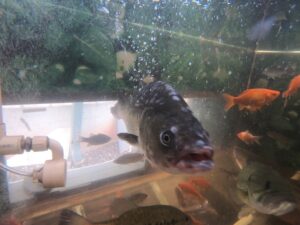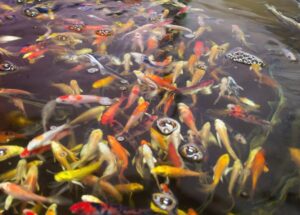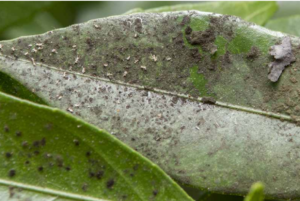There are a few fish conditions to watch for in your aquarium: fish disease, parasites, fungi, and bacteria. These symptoms can all appear in your fish tank and quickly spread disastrous effects on the fish. The chance of fish disease or stress is especially high when you introduce new fish or add new water to your system, as the new fish might have brought diseases with them.
Prevention is the best way to prevent disease in fish, and recognizing the signs of fish diseases can help you avoid the loss of fish in your aquaponics system. In preventing fish disease, it is essential to check your fish regularly for any of the following signs:
- Check their appearance regularly because several parasitic and fungal infections can be visible on the fish skin, scales, or fins.
- Check for behavior changes, such as your fish becoming lethargic, refusing to eat or changing feeding habits, changing swimming patterns, odd position in the water, head, or tail down, difficulty maintaining buoyancy, and fish gasping at the surface.
- If your fish looks bloated or its scales seem raised, it also indicates health concerns.
Most external signs of disease are:
- Ulcers on the body surface, discolored patches, and white or black spots.
- Fin rot, ragged fins, or exposed fin rays.
- Abnormal body configuration, twisted spine, and deformed claws.
- Swollen appearance and cotton-like lesions on the body.
- Exophthalmia or swollen popped eyes.
What are The Causes of Fish Disease?
Fish diseases can be introduced by adding new fish, poor water quality, live food, invertebrates, or equipment used in the system. Fish also carry bacteria, viruses, fungi, and parasites like other animals. Though not all these bacteria are harmful, some of these microorganisms, called pathogens, can potentially cause fish diseases.
The following factors can cause fish disease in your aquaponics system.
- Adding new fish to the system
- Environment or poor water quality
- Fish stress
- A poor or unbalanced diet
- The equipment used in the system is not suitable for the fish.
- Not getting along with other fish species in the fish tank.
One of the most important things with aquaponics is to remember that the entire greenhouse system is affected as fish and plants coexist in a delicate symbiosis, preventing fish diseases is a fundamental pillar for sustainable success. The health of fish directly influences the overall functionality and productivity of the aquaponics environment, and understanding fish diseases, their symptoms, and the factors that contribute to their occurrence lays the groundwork for effective prevention.
Fish Disease Prevention Measures
1. Quarantine Procedures for New Fish
a. Isolation Period:
- Establish a dedicated quarantine tank or area for newly acquired fish.
- Isolate new additions for a predetermined period, typically two to four weeks.
- This allows for observing potential diseases before introducing fish to the aquaponics system.
b. Health Assessment:
- Conduct a thorough health assessment of new fish during quarantine.
- Look for signs of diseases such as lesions, abnormal behavior, or external parasites.
- Treat any identified health issues before integrating fish into the central system.
c. Preventive Treatments:
- Consider preventive treatments during the quarantine period to prevent the introduction of pathogens.
- Use medications that are safe for both the fish and the aquaponics system.
- Monitor fish closely during treatment to ensure their well-being.
Common Fish Diseases
1. Fish Fungus

Also known as cotton wool disease or fuzzy fish, the fish fungus looks like a cotton-like growth on the skin or fins. Fungal spores are common in poorly maintained tanks, poor water conditions, or damaged fish tissues from wounds.
Symptoms of Fish Fungus
- Abnormal behavior
- Open sores
- Cotton-like growths on the body (white, brown, or gray color)
- Bruised-looking and reddish eyes.
Treatment
The first important thing you need to do is a water test to establish if poor water conditions cause fish disease. If there are other problems, such as ammonia and nitrite levels, then you must ensure that ammonia and nitrite levels are within their ideal range.
2. Fish Stress
Stress can be detrimental to fish, just as it is for humans. Prolonged fish stress can result in bad health outcomes.
Stress in fish can be caused by:
- Fast temperature changes or temperature is outside of the ideal range.
- Poor water quality, pH, high nitrate, nitrite, and ammonia levels.
- Bullying by other fish in the fish tank
- Low dissolved oxygen, pump failure, or power outages
Symptoms of fish stress:
- Fish are skittish and easily disturbed.
- Gasping at the surface
- Poor Appetite
- Strange swimming patterns
- Rubbing or scraping at the sides of the tank
- Physical Injuries
- Improper fish handling
- Improper feeding
- overcrowding in the fish tank
Avoid and treat fish stress by:
- Cleaning and maintaining the water quality in your system.
- If your system has visible solids in the water, fit a filter or settlement tank.
- Feed fish with correct feeding rates and remove uneaten fish food after feeding.
- Ensure that your system is within the parameters of pH, ammonia, nitrites, and nitrates.
- Ensure enough aeration.
- If there is an identifiable fish bully in the tank, remove the bully fish.
- Minimize scooping fish out of the tank for inspection (only do this if necessary) and reduce the frequency of opening and closing the tanks.
- Treat the disease immediately once identified.
3. Nitrite Poisoning
A new aquaponics system is more vulnerable to nitrite poisoning, especially when beneficial bacteria do not yet colonize them. However, nitrite poisoning is not just limited to new systems; established aquaponics systems can have nitrite poisoning when the nitrites level goes over six ppm.
Nitrites poisoning can be caused by:
- Overfeeding the fish
- Overstocking
- Improper filter maintenance
- Washing the grow bed because it also washes away bacteria
Symptoms of nitrite poisoning:
- Difficulty breathing
- Darker gills
- Tan or brown gills.
- Faster gill movement
- Swimming near the surface
- Lethargy
- Redness around the eyes and fins
Treatment of nitrite poisoning:
Lower the nitrite level in the fish tank by:
- Change 25 – 50% of the water in the fish tank with good quality water, and keep changing the water until the ammonia and nitrite level is zero.
- Stop or reduce feeding, and do not add new fish to the fish tank until the ammonia and nitrite levels are normal.
- Remove uneaten fish food and clean the fish tank.
- Ensure that the tank has enough aeration or add an extra aerator.
- Adding half an ounce of salt for each gallon of water can prevent methemoglobin buildup. It will also minimize nitrite’s influence to strip oxygen from the bloodstream. It is suggested that 2lb of salt is an effective dosage for 300 gallons of water. But salt does not evaporate, so take note of when and how much salt you add to your tank.
4. Fin Rot
Fin rot can be caused by bacteria, fungi, or parasites. It is most commonly the result of a bacterial infection (Pseudomonas fluorescens, which causes a ragged rotting of the fin), or as a fungal infection (which rots the fin more evenly and is more likely to produce a white “edge”).
Symptoms of fin rot:
- Fin edges turn black / brown
- Fins fray
- Base of fins inflamed
- Entire fin may rot away or fall off in large chunks
- Fins have white dots
Treatment of fin rot:
- Remove and isolate sick fish from the greenhouse
- Change the water and check filters
- Treat fish with a suitable treatment such as phenoxyethanol, malachite green methylene blue or other proprietary agent (most seem to prefer aquarium salt; however, it is important to make sure the product is for freshwater, not saltwater, fish).
- Find out the pH and correct it if necessary.
- Use antibiotics if the rotting is jagged.
- Use antifungal medication if the rot is more evenly spread out and the fin has holes. This may also be a symptom of an external columnaris infection, especially if it progresses rapidly (within 24 hours) and the rotted edge has a white, fuzzy appearance.
- Water temperature should be changed to 24–26 °C.
Prevention of fin rot:
Fin rot can be prevented with good water quality, feeding fresh food in small portions and maintaining constant water temperature. Keeping the tank from becoming cluttered (for domestic fish) will also help prevent fin rot.
5. Ichthyophthirius (Ich or White Spot Disease):
White spot disease is caused by a protozoan parasite. It can infect most freshwater fish species.
- Manifests as white cysts on fish skin and gills, leading to irritation and increased mucus production.
Treatment of Ich:
Environmentally friendly products include hydrogen peroxide and hydrogen peroxide releasing products such as sodium percarbonate and peracetic acid, however check to make sure they are safe for aquaponics. These compounds can be added to the fish tank water and eliminate the parasite in it’s early stages but do not affect the later stage in the fish skin.
Recently, a wide series of herbal extracts have been shown as effective, including garlic juice, which has a toxic effect on the parasite.
6. Columnaris Disease:
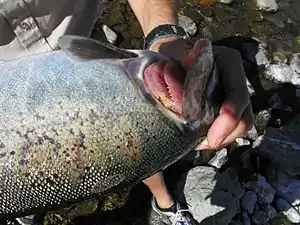
Columnaris (also referred to as cottonmouth) is a symptom of disease in fish which results from an infection caused by a bacterial infection. The bacteria usually enter fish through gills, mouth, or small wounds, and is prevalent where high bio-loads exist, or where conditions may be stressful due to overcrowding or low dissolved oxygen levels in the water column.
Symptoms of cottonmouth disease:
- white or grayish lesions on the skin, gills, or mouth, often resembling cotton wool.
- Indicates internal organ failure.
- Symptoms include bloating, raised scales, lethargy, and difficulty swimming.
- Rapid breathing.
Treatment:
Isolate sick fish, then treatments can be applied. Potassium permanganate, copper sulfate, and hydrogen peroxide can be applied externally to adult fish and fry, but can be toxic at high concentrations. Vaccines can also be given in the face of an outbreak or to prevent disease occurrence.
7. Dropsy:
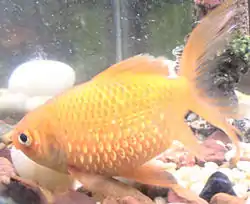
Dropsy is a condition in fish caused by the buildup of fluid inside the body cavity or tissues. As a symptom rather than a disease in its own right, it can indicate a number of underlying diseases, including bacterial infections, parasitic infections, or liver dysfunction.
Symptoms of dropsy:
- Swelling of the abdomen
- Eyes that are beginning to swell and bulge
- Scales that starting to point outward instead of lying flush with their body giving a “pinecone” appearance
- Loss of color in their gills
- Clamping of the fins
- Curve developing in their spine
- Pale feces
- Swelling near their anus
- Loss of appetite
- Lack of energy and movement
Treatment:
Because dropsy is a symptom of an illness, its cause may or may not be contagious. However, it is standard practice to quarantine sick fish to prevent spreading the underlying cause to the other fish in the tank community
8. Gill Flukes:
Gill Flukes are internal parasites. They show up as a parasitic infestation in the gills.
- Signs include labored breathing, increased mucus production, and inflammation of the gills.
9. Ulcers:
- Bacterial infections often cause open sores.
- External lesions and tissue damage characterize this condition.
How to Prevent Fish Diseases
- Purchase healthy fish from a reliable and reputable fish supplier.
- Quarantine new fish in a separate tank before introducing them into an established fish tank.
- Feed the fish with a proper, varied, and well-balanced diet.
- Keep your system’s water quality clean at all times and ensure that it is within the critical water quality parameters of pH, ammonia, nitrites, nitrates, and the temperature of your fish.
- Ensure enough aeration to keep the DO as high as possible.
- Remove uneaten fish food from the tank.
- Ensure that the water is from a good source, clean, and free of chlorine.
- Make sure that the fish tank is in an excellent shaded place.
- Follow the standard hygiene procedure by washing hands and using clean gear or equipment.
- Treat the disease as soon as it is identified.
Fish health in your aquaponics system may also be affected by improper salinity, too much aeration, and lack of food. However, with proper aeration and the right fish food, these factors will not affect the health of your fish.
In managing fish health in your aquaponics system, keeping your water within its parameters, giving your fish the right fish food, and following the aquaponics maintenance tips are essential.


